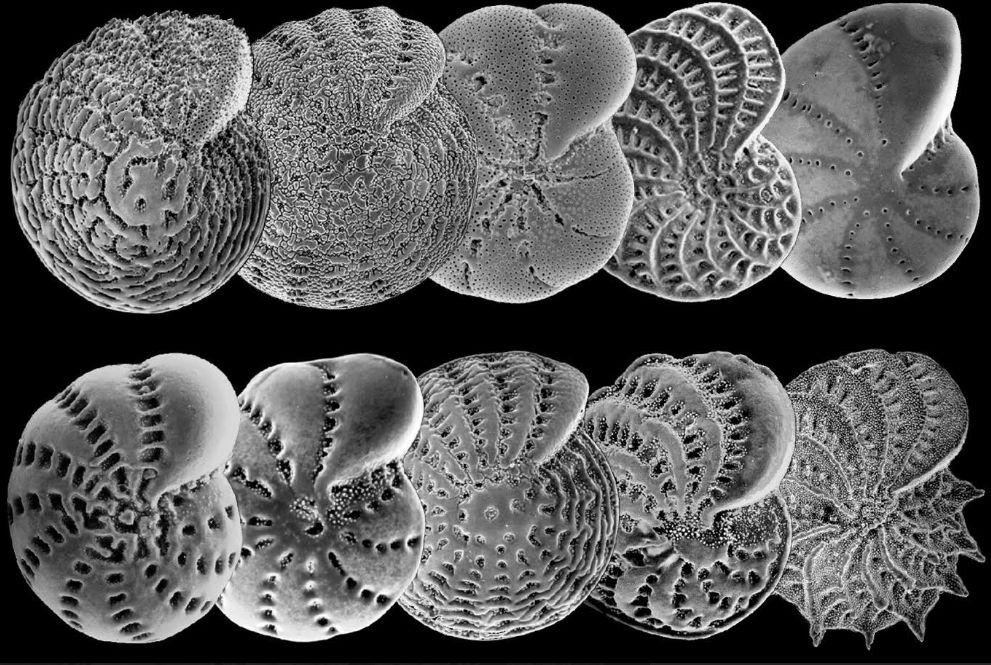13 November 2025
A four-year study just published
in the international journal Micropaleontology records 57
new species of small marine animals (Foraminifera) from
around the world. Forty-one of these new species are
described and named. The multinational study was led by
retired Auckland marine biologist Dr Bruce Hayward. Other
members of the 5-person study team are from Australia,
Japan, Switzerland and Germany.
The study undertook a
complete global review of all the living species in four
related families of shallow marine foraminifera. This is
only the second global review of a group of foraminifera
undertaken using a combination of DNA sequencing and
morphological characters. The first such global study was
undertaken by the same NZ-led group of scientists and
published in 2021.

of the shells of various species of foraminifera studied by
the New Zealand-led team. Each shell is about 0.3 mm in size
(Photo/Supplied)
This new study
found that the greatest diversity in these families occurred
in the northwest Pacific with 74 species living around the
coasts of China and Japan. Next most diverse is the coast of
Australia with 58 species. The only region lacking any of
these families is Antarctica but 24 species live around the
shores of the Arctic Ocean.
The newly recognised
species come mostly from the Southern Hemisphere, where they
have been less studied over the past 250 years. The first
named species in these families was described from the
Mediterranean by Carl Linnaeus in 1758. The greatest number
of new species come from around the coast of southern Africa
(13), followed by Australia (9), Northwest Pacific (8),
Mediterranean (5), northern Indian Ocean (5), South America
(4), New Zealand (3), Pacific Islands (3), Indonesia (3),
Caribbean (2), Arctic Ocean (1) and the Black Sea
(1).
Advertisement – scroll to continue reading
“This new study brings the number of recognised
species in these families around New Zealand up to 18,”
said Dr Hayward. “The types of the three new New Zealand
species were collected from Stewart Island, Tolaga Bay and
the Waitemata Harbour. They are now housed in the
collections of the Museum of Auckland and Earth Science New
Zealand.”
Foraminifera are tiny marine organisms
similar to amoeba but have chambered shells. Their average
size is about 0.4 mm. The foraminifera studied live in their
trillions in sea-floor sand and mud in estuaries, harbours,
bays and offshore down to about 100 m depth. There are
currently 9000 species of living foraminifera in the world
and 40,000 described extinct fossil
species.
“Foraminifera are widely used to study the
impacts on coastal ecosystems of pollution and sediment
runoff; to document sea level changes that occurred before
tide gauges existed; to study the frequency and size of
coastal earthquake displacements and tsunamis; and in the
study of past and present climate change,” said Dr
Hayward. “We need to be able to identify the foraminifera
to be able to use them in these applied
studies.”
“Foraminifera are among the most useful
for these studies because their shells that are preserved in
sediment sequences provide a record of past environmental
changes. The specific foraminifera that have been reviewed
by our group are among the most important world-wide for
these studies,” Hayward said.
“Another outcome of
this study was to recognise the enormous extent of
accidental human-related transport of marine species around
the world in the last few centuries. At least 33
non-indigenous species have been recognised living in places
on the opposite side of the world from where they naturally
occurred for millions of years prior to now,” said
Hayward.
Source link
